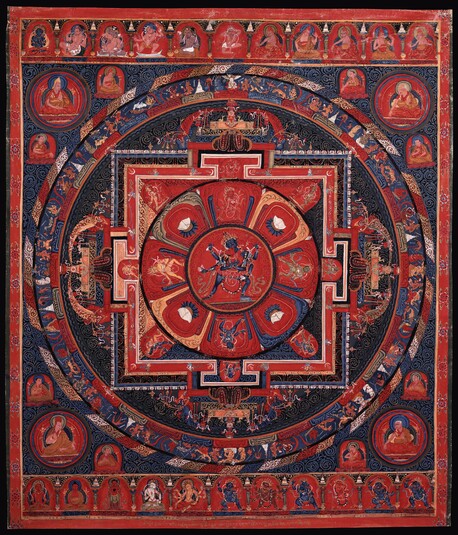
Item: Mandala of Chakrasamvara (Buddhist Deity) - (Maitripada Tradition)
| Origin Location | Tibet |
|---|---|
| Date Range | 1500 - 1599 |
| Lineages | Sakya, Ngor (Sakya) and Buddhist |
| Size | 54.61x44.45cm (21.50x17.50in) |
| Material | Ground Mineral Pigment on Cotton |
| Collection | Rubin Museum of Art |
| Catalogue # | acc.#C2001.9.1 |
Classification: Deity
Appearance: Semi-Peaceful
Gender: Male
Chakrasamvara, Thirteen Deity Samvarodaya Chakrasamvara Mandala (Tibetan: khor lo dem chog lha chu sum gyi kyil kor) from the Shri Maha Sambarodaya Tantraraja [TOH 373, Ngor 72]. Explore the Symbolic Elements of this Mandala.
Tibetan: Khor lo dem chog
Within the center of the two-dimensional circular diagram (mandala) representing the top view of a three-dimensional celestial palace and surroundings is the tutelary deity Chakrasamvara, blue-black in colour, with three faces and six hands. In the first pair of hands are a vajra and bell crossed at the heart embracing the consort red Vajravarahi, surrounded by the flames of pristine awareness.
The painting style, heavily influenced by Nepali aesthetics and a strong penchant for red, is typical of older Sakya and Ngorpa 'tangkas' and wall murals.
Jeff Watt 5-2003
Chakrasamvara is one of the most popular deities in Tantric Buddhism. He can appear in several dozen different forms, which makes it necessary to rely on the descriptive literature in the Sanskrit and Tibetan languages to identify him. Adding to the complexity, there are more than fifty different traditions of these forms in Tibetan Buddhism. They are meant to emphasize different types of meditation practice that are suited for specific types of emotional and psychological characteristics in the tantric practitioners who take on these intricate practices. The form of the subject of this painting is the Thirteen Deity Samvarodaya Chakrasamvara Mandala as described in the Sanskrit text the Shri Maha Samvarodaya Tantraraja [TOH 373, Ngor 72].
Within the center of the mandala, representing the view from above of a three-dimensional celestial palace and surroundings is the meditational deity Chakrasamvara, blue in color, with three faces and six hands. In one first pair of hands crossed at the heart he hold a vajra and bell and is embracing his consort red Vajravarahi. The couple is surrounded by the red flames of pristine awareness. Immediately around the central figures are four female figures: Dakini, Lama, Khandarohe, and Rupini. In the surrounding square are four more figures along with another four standing at the T-shaped structures of the outer square. Lineage teachers are depicted in the top register and arranged around the mandala circle at the left and right.
In the bottom register are various deities auspicious for long life, purification, wealth, and protection. Often the only visual depictions of rare forms of deities are found in paintings such as this. These deities are placed in the bottom registers of paintings that are created as sets. Large numbers of figures are needed to fill the compositions of these sets, which often number more than twenty paintings in total.
The painting style here, heavily influenced by Nepali aesthetics and a strong liking for red, is typical of fifteenth and sixteenth century Sakya and Ngor paintings and wall murals. At the bottom of the painting in the red border is a four line verse of dedication that reads, 'Created for the long-life of the glorious revered teacher Konchog Pelwa (1445-1514 [TBRC P1873]) by the Vidyadhara Lhachog Sengge.' Lhachog Sengge (1468-1535), who commissioned this painting, was a famous abbot of Ngor Monastery in Tibet and responsible for the creation of many works that have found their way into collections in Europe and North America.
Jeff Watt 10-2008
Front of Painting
English Translation of Inscription: Created for the long-life of the glorious revered teacher Konchog Pelwa by the Vidyadhara Lhachog Sengge.
Wylie Transliteration of Inscription: rje btsun bla ma dam pa dkon mchog ''phel sku tshe brtan pa''i phyir du. rig pa ''dzin pa lha mchog seng ges gzhengs.
Exhibition: Mandala, The Perfect Circle (RMA)
Thematic Sets
Collection of RMA: Ngor Style Paintings
Subject: Ngor Masterworks
Subject: Greyscale - Figurative & General Composition
Tradition: Sakya Painting & Sculpture Chronology - Dated
Collection of Rubin Museum: Mandala Masterworks
Collection of Rubin Museum (Interesting Mandalas)
Teacher: Lhachog Sengge (Commissioned Paintings)
Mandala: Religious Context
Collection of Rubin Museum of Art: Mandala
Buddhist Deity: Chakrasamvara Art History
Teacher: Lhachog Sengge & Commissions (RMA)
Collection of Rubin Museum of Art (RMA): Main Page
Buddhist Deity: Chakrasamvara (Mandala Masterworks)
Mandala: Sakya Masterworks
Collection of Rubin Museum: Mandala Masterworks (Curator's Selection)
Buddhist Deity: Chakrasamvara Mandala

